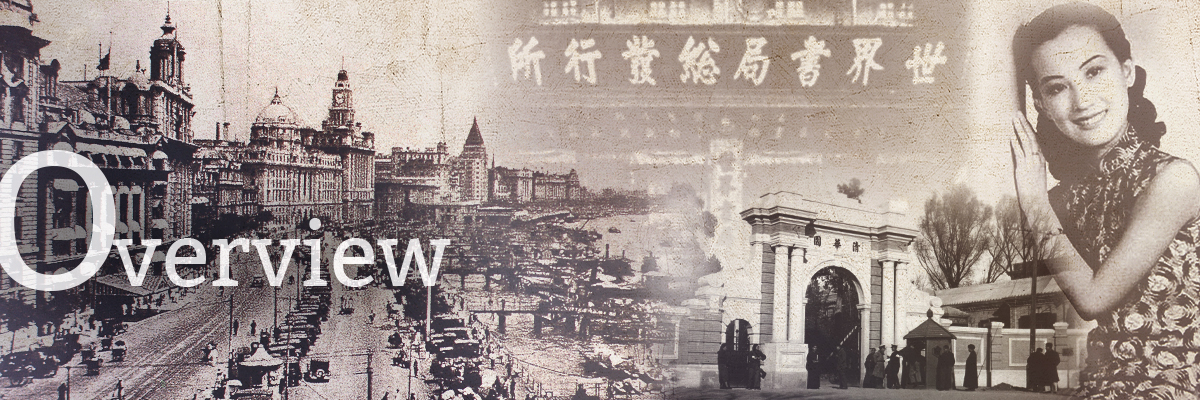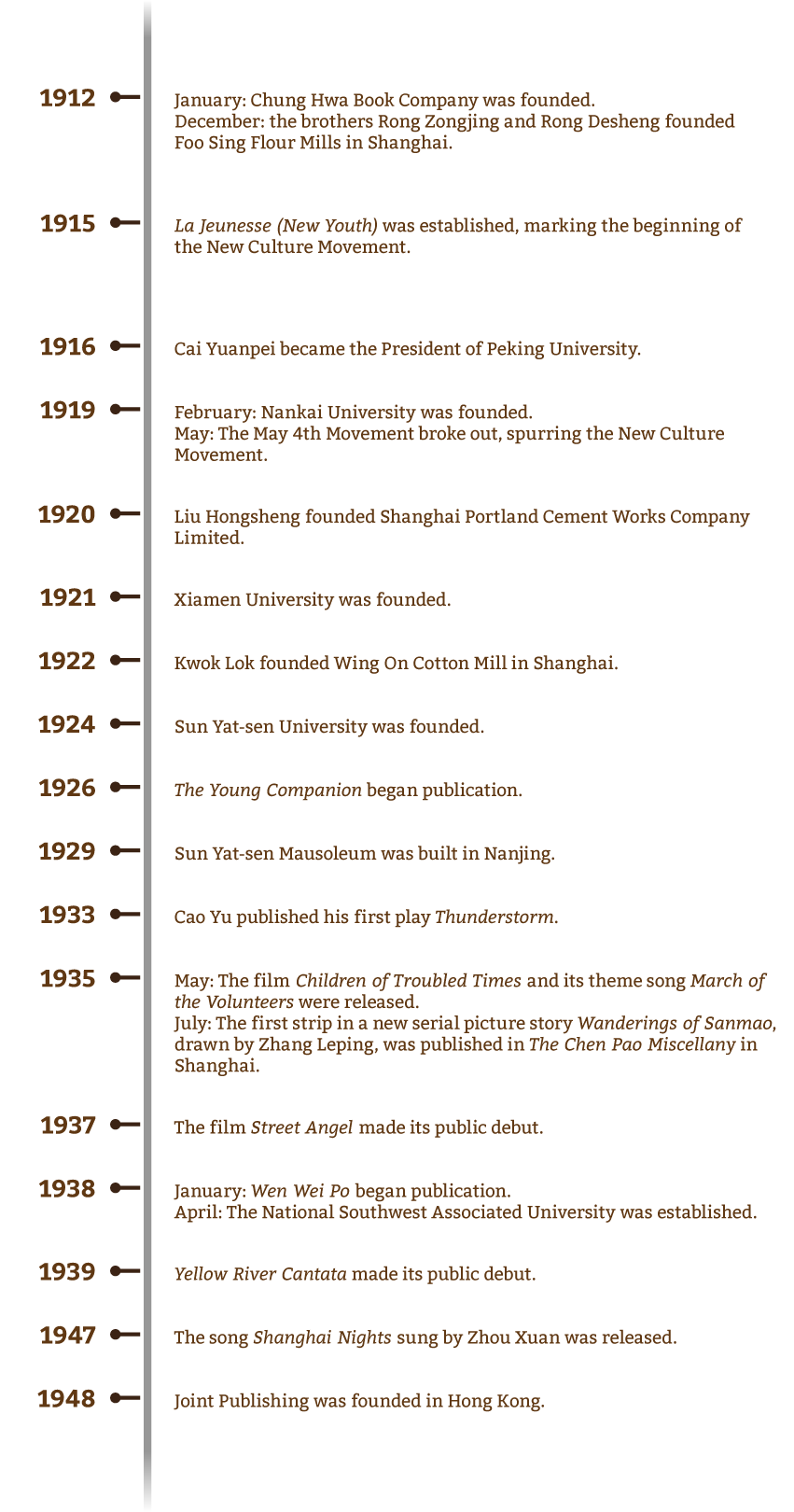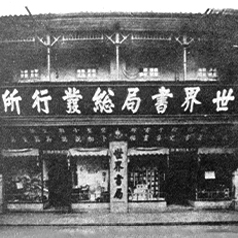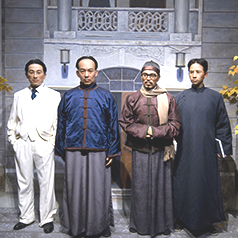Although despotism, internal and external challenges remained following the fall of the Qing dynasty (清朝) and the founding of the Republic of China (ROC) in 1912, the country still witnessed certain economic and cultural development and changes in social life.
First of all, China saw a rapid increase in national bourgeoisie capital as major foreign powers were embroiled in World War I. National industries thus ushered in a “transient spring”. For urban development, Shanghai (上海) gradually developed into the fourth-largest world metropolis and the largest city in the Far East. Economic development was greatly impeded, however, by 10 years of armed confrontation between the Kuomintang of China (中國國民黨) and the Chinese Communist Party (中國共產黨), eight years of the Total War of Resistance Against Japanese Aggression, and four years of the subsequent civil war. By 1949, the value of modern industrial production only accounted for 17 per cent of the domestic production value.
For cultural and educational development, the ROC made significant achievements, especially considering its short lifespan of just over three decades. National Central University (國立中央大學), Peking University (北京大學), Tsinghua University (清華大學), Zhejiang University (浙江大學), and Wuhan University (武漢大學) were recognised as the five most prestigious national universities in China. Greatly admired at that time were Peking University, with Cai Yuanpei (蔡元培) as President and Chen Duxiu (陳獨秀) and Hu Shi (胡適) among its faculty, as well as Tsinghua University with its four illustrious professors, namely Wang Guowei (王國維), Liang Qichao (梁啟超), Chen Yinke (陳寅恪), and Zhao Yuanren (趙元任). Other storied universities included Fudan University (復旦大學), Jinan University (暨南大學), Nankai University (南開大學), Xiamen University (廈門), and Sun Yat-sen University (中山大學) also cultivated a wealth of talented students and produced many fruitful results. During the eight-year War of Resistance, the National Southwest Associated University (西南聯合大學) nurtured a multitude of talents for the country. In addition, the contributions of scholars like Hua Luogeng (華羅庚), Li Siguang (李四光), Qian Xuesen (錢學森), Qian Weichang (錢偉長), Qian Sanqiang (錢三強), Deng Jiaxian (鄧稼先), and Zhao Jiuzhang (趙九章) laid a great foundation for China’s future scientific and technological development.
Literature and art flourished in the Republican period, evidenced by the blooming of various schools. Literary masterpieces include The True Story of Ah Q (《阿Q正傳》) by Lu Xun (魯迅), Rickshaw Boy (《駱駝祥子》) by Lao She (老舍), Family, Spring, and Autumn (《家》、《春》、《秋》) by Ba Jin (巴金), Midnight (《子夜》) by Mao Dun (茅盾), To Young Readers (《寄小讀者》) by Bing Xin (冰心), and Thunderstorm (《雷雨》) and Sunrise (《日出》) by Cao Yu (曹禺). Renowned painters such as Li Shutong (李叔同), Liu Haisu (劉海粟), Zhang Daqian (張大千), Xu Beihong (徐悲鴻), Feng Zikai (豐子愷), and Qi Baishi (齊白石) each demonstrated their talents through marvellous works of art. Liu Tianhua (劉天華) and Wang Luobin (王洛賓) carried on the legacy of folk music while Nie Er (聶耳) and Xian Xinghai (冼星海) created the inspiring song March of the Volunteers (《義勇軍進行曲》) and Yellow River Cantata (《黃河大合唱》). Traditional operas developed steadily, including Peking Opera (京戲), Yue (Shaoxing﹝紹興﹞) Opera (越劇), Cantonese Opera, Yu (Henan Province﹝河南﹞) Opera (豫劇), Ping Opera (評劇), and Huangmei Opera (黃梅戲). Film production thrived as well, generating such stars as Ruan Lingyu (阮玲玉), Hu Die (胡蝶), Zhou Xuan (周璇), Zhao Dan (趙丹), and Jin Shan (金山).
Journalism and publishing also prospered. In 1947, the number of registered newspaper offices reached 1,781 in the Nationalist Government-controlled areas. Shen Bao (《申報》), Sin Wan Pao (《新聞報》), Ta Kung Pao (《大公報》), and Wen Wei Po (《文匯報》) were quite popular at that time, while La Jeunesse (New Youth,《新青年》) set the ideological trends. For publishers, brilliant achievements and outstanding contributions came from the Commercial Press (商務印書館), Chung Hwa Book Company (中華書局), Dah Tong Book Company (大東書局), World Book Company (世界書局), Kaiming Book Company (開明書店), and Joint Publishing (三聯書店).
After the founding of the ROC, new culture spread in the absence of the imperial system, and Chinese social life and customs thus slowly transformed. Longstanding traditions such as men keeping long braids, women binding feet, arranged marriages, and child brides were gradually abandoned. As interactions between traditional Chinese and Western cultures intensified, many practices in clothing, food, housing, calendars, festivals, and other areas blended. Bad habits, however, failed to be eradicated, including opium smoking and gambling. Social conditions during the Republican period showed that a short round of reforms can hardly rid a country of millennia-old social customs. Revolution is effective in changing regime but not in making a clean break from the past ways. Besides, many old traditions have their merits and are worthy of continuation.









